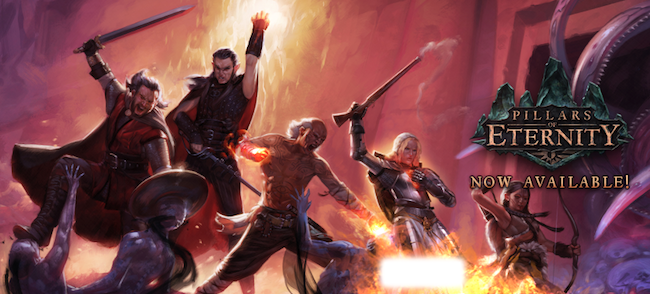
Pillars of Eternity is a title that I have personally been looking forward to since the launch of Kickstarter three years ago. While some minor concern was warranted coming into this game (based on the previews leading up to release), I was pleasantly surprised when I finally dived into the richly detailed world of Eora. Obsidian did an excellent job recreating the look and feel of older RPGs, but with a modern angle and superior presentation. With a huge amount of content and an epic world to roam around in, the final product is both wonderfully constructed and presented.

Act 1, Scene 1 introduces players to the game via a narrator that sets up the overarching story, and with a voice that could not be better suited to narrate an RPG. As the player travels the open road, for reasons that are decided through the in-depth character creation system, the protagonist falls extremely ill. While looking for a remedy, it is revealed to the player that they are a Watcher: a being that can communicate with the souls of others that inhabit the world, be they living or dead. Through this power, various plots are uncovered by revealing others’ pasts and secrets, thus setting the player off on an adventure filled with side-quests, monsters to fight, and dungeons to explore.
In saying that, the main story didn’t capture my attention as much as the content of the world itself. The lore behind the cities, dungeons and even weapons are really well-written; with these texts doing an excellent job in spurring me on simply for the sake of wanting to learn more about the world. The inhabitants of Eora were just as engaging for the most part. The companions I met all had fantastic backstories, and I was invested in completing each of their personal quests, which were further fleshed out thanks to second to none voice acting. As well as in-game companions, the option to create your own custom party member at every town was something I also enjoyed. I exercised my personal character development and constructed a party member with a distinct background to fit with my playthrough.

Something else about the narrative that especially appealed to me were the dialogue choices, and how they would influence your character’s progression as well as the resulting path that the game would take. As I played, I felt a genuinely distinct personality develop about my character as I focused primarily on levelling up stats and training her for combat. The result of this approach was an arrogant Cypher with a god-like complex. What I really appreciated about this, however, were that the dialogue options that met with her personality weren’t necessarily the ones that I would have chosen but were choices my character would make as she developed. All this tempted me to start various other playthroughs out of curiosity to see what other characters I could evolve given a different approach.
What did bother me, however, is how poor of an effort was made to incorporate backer content into the world of the game. This issue was so prevalent that a notice was placed on the loading screen warning players who wanted an immersive experience to avoid gravestones in the world marked as backer content. Personally, I found the stories attached to backer NPCs very lengthy and tedious enough that I mostly went out of my way to avoid all of this content. Though, to be fair, this content was almost a necessity for Pillars of Eternity to have reached the state it is in, and when you know what to look for, it’s not really a major hassle to avoid it and stick to the main world.

With a strong foundation and narrative framework, the developers have done a fantastic job in nailing exactly what makes older RPGs great. At the same time, Pillars of Eternity understands what type of game it is and does not push itself to try anything too innovative. Being a Kickstarter game, it was probably in the best interest of Obsidian to be “safe” with this title. But in saying that, I personally enjoyed how unashamedly classic it was in its design. The aspects that are executed are done as well – if not better than – similar titles such as Baldur’s Gate and Icewind Dale. Straight away from the character customisation, I was made well aware of the caliber of game Obsidian was trying to deliver.
The layout of the world is also well designed, even if it is not especially expansive. Although, that said, the game is still packed full of interesting areas for players to explore. For example, there was one particular dungeon which lay under my stronghold (a headquarters where I could upgrade, hire mercenaries and offer numerous services) that I really enjoyed. It was quite large, and a great portion of my playtime was actually spent crawling through it. Often, I would go from room to room uncovering mysteries until the monsters would become too overwhelming. This is where I would return to the main quest – to become stronger – and then dive back in so I could plunge deeper into its depths.

I actually found this style of play was actively encouraged, which, in turn, created a fantastic progression curve. No matter how overwhelmed you would feel, there was always somewhere else you could go to explore and build up your party. In fact, this process is a crucial part of the game because discovering new locations and completing quests are the only way that you can gain experience in Pillars of Eternity. The option to simply farm monsters is not available as they do not respawn. Although, don’t let that worry you, the experience has been deliberately designed this way. You see, levelling up serves as your motivation to both explore and clear out the game, and, in turn, make more areas accessible. Thankfully, too, the world of Eora remains pretty stable throughout your cleaning spree.
Stability is usually the bane of RPGs such as this, so when compared to other titles, Pillars of Eternity was fairly stable coming out the gate. This isn’t saying much though; some major bugs simply broke the game, such as having certain characters’ defensive buffs within battle continue outside of combat and stack when used again, and creating ridiculously overpowered tanks. Another was having your characters’ passive buffs get permanently wiped out by double-clicking on an item in order to equip it. All this being said, Obsidian released a patch addressing all my gripes within a week, as well as a page long list of fixes for issues I was not aware of. As well as the initial patch, another patch has been released to further enhance the gameplay – making this game the most stable RPG in my library.

The game itself plays like every other RPG from the Infinity Engine days. Once again, Obsidian knew what it was creating and went on to polish what works rather than risk something new. Typical issues within RPGs are still evident, like character patching and having party members remain completely idle while combat is happening. Occasional battles were lost due to my six-member party getting crammed in a door or stuck behind each other. However, in the later stages, I found strategic placing of members necessary to win fights that made these issue less observable, as every move had to be deliberate and tactical. With one of the most intuitive UI systems I’ve seen in an RPG of this style, combat was rarely a hassle and at times resulted in lengthy epic standoffs.
With all of that being said, you’re very likely be staring at the screen for hours on end, and, fortunately, that’s not going to be a problem. The aesthetics of the game is one area where it genuinely shines. You see, all the environments within the game have been hand painted, creating an absolutely stunning world which I thought was enthralling to explore. It’s very reminiscent of that older RPG graphical style which uses highly detailed backgrounds in combination with interactive sprites. With the addition of a soundtrack which is perfectly matched with the look and feel of the game, Pillars of Eternity, without a doubt, pays excellent homage to the Infinity Engine, while taking it one step further.
 Successfully builds upon the RPGs of old
Successfully builds upon the RPGs of old
 Engaging lore and character backstories
Engaging lore and character backstories
 Fantastic dialogue and world progression
Fantastic dialogue and world progression
 World exploration is actively encouraged
World exploration is actively encouraged
 Environments are extremely well presented
Environments are extremely well presented
 The main narrative is a bit dull
The main narrative is a bit dull
 Minor bugs still prevalent
Minor bugs still prevalent
 Backer content is poorly implimented
Backer content is poorly implimented
Pillars of Eternity is what RPGs should aspire to be, delivering almost everything that seasoned fans would come to expect from the genre. Essentially, Obsidian knew what kind of experience they were crafting and stuck to what made classics such as Balder’s Gate as great as they were. Coupled with an immaculate art style and a fantastic world to explore, Pillars of Eternity also stands clearly above similar titles of this style. Players may have to have an interest in traditional RPGs to appreciate the beauty of this game, but I am more than happy to have this title in my library, and can see myself diving into this world over and over again. If you’re a fan of older RPGs, definitely don’t miss this one.











